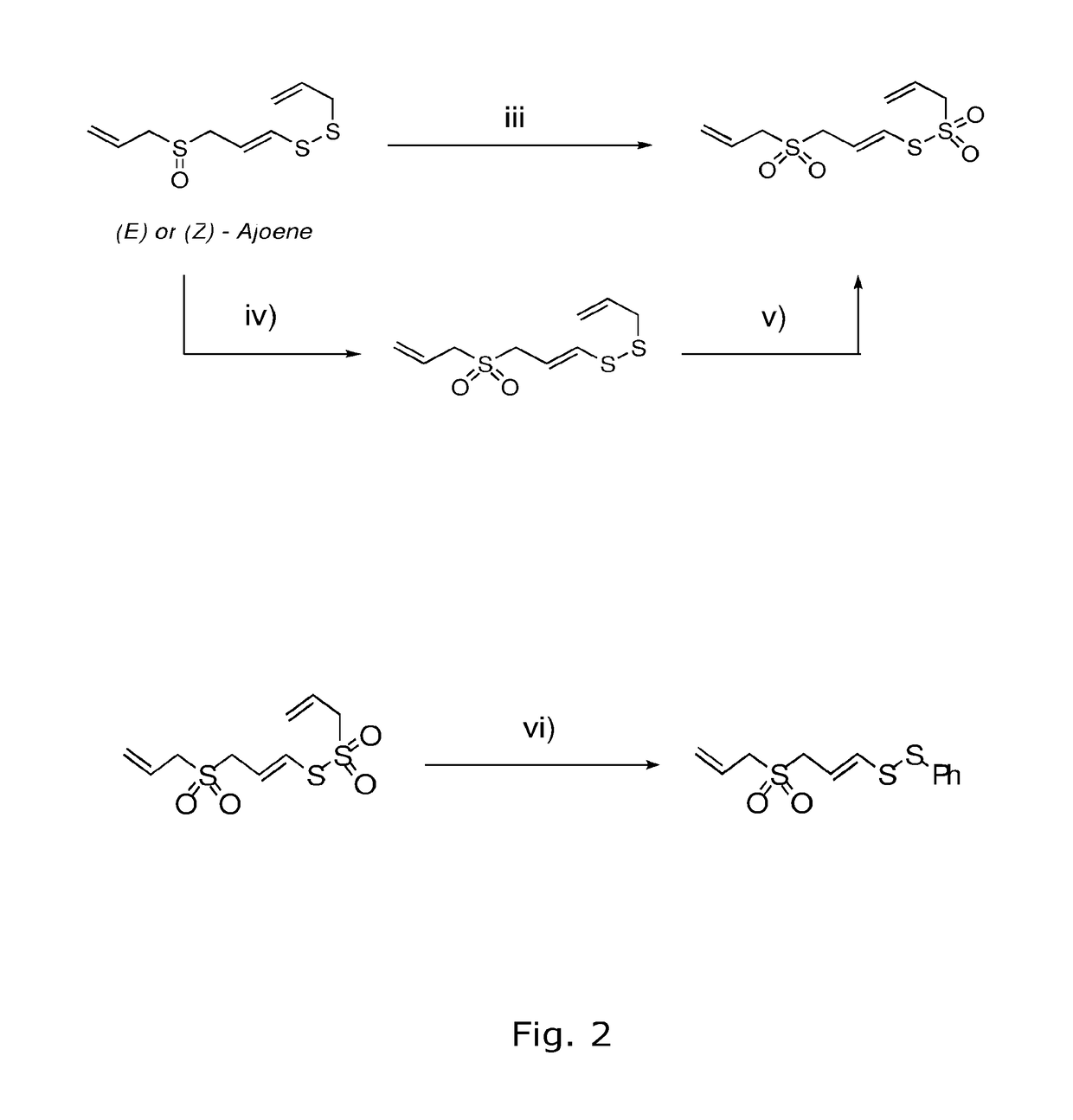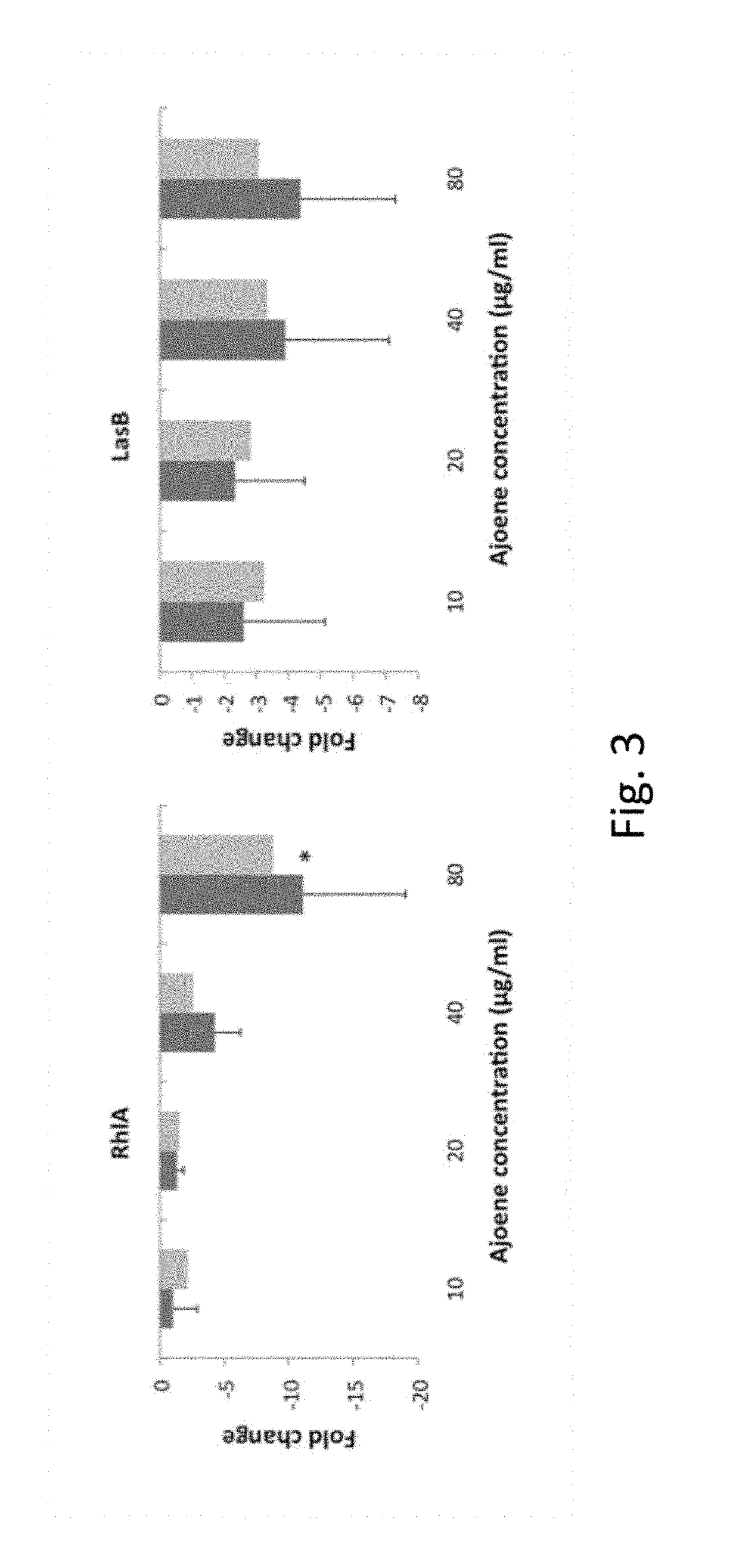Process for the manufacture of ajoene derivatives
a technology of ajoene and ajoene, which is applied in the field of chemical processes, can solve the problems of high purification cost, high labor intensity and inefficiency in garlic isolation, and low product yield of ajoene, and achieve the effect of time-consuming and expensive purification procedures and low product yield
- Summary
- Abstract
- Description
- Claims
- Application Information
AI Technical Summary
Benefits of technology
Problems solved by technology
Method used
Image
Examples
example 1
Synthesis of Compound (3), Allicin
[0073]An acetone solution of DMDO (31 mL, 0.07M, 2.2 mmol) was added dropwise over 15 min to compound (2), diallyldisulphide (0.29 g, 2.0 mmol) in acetone (1 mL) at −50° C. under argon. The resulting light yellow reaction mixture was allowed to stir for 30 min while slowly warming to −20° C. The resulting clear reaction mixture was concentrated in vacuo. The crude residue (0.31 g, 98%) was further purified by column chromatography (eluting with 5% Et2O in pentane) to yield compound (3), allicin (0.31 g, 1.9 mmol, 96% yield, purity >95% and up to 99.9%) as a light yellow liquid.
[0074]The above reaction was repeated under varying condition with respect to solvent and temperature. Remaining parameters were kept the same. As seen in table 1 below the reaction is effective under a number of conditions.
TABLE 1Conversion of diallyldisulphide to allicin (3)EntrySolventTemp2 / Yield1Acetone−100° C., 78° C., −50-−20° C.96%2CH2Cl2−100° C., 78° C., −50-−20° C.90%...
example 2
Synthesis of Compound (1), (E,Z)-Ajoene Using Acetone Solvent
[0075]A solution of compound (3), allicin (0.162 g, 1.0 mmol) in a 40% aqueous acetone solution (1.6 mL) was treated with AcOH (0.011 mL, 0.2 mmol). The resulting mixture was heated to 64° C. for 4 h. The cooled reaction mixture was diluted with 50% aqueous methanol (6 mL) and extracted with pentane (5×10 mL). The aqueous fraction was saturated with solid NH4SO4 and the mixture was extracted with CH2Cl2 (5×10 mL). The combined organic extracts were dried (Na2SO4) and concentrated in vacuo. The crude residue (0.16 g) was further purified by column chromatography (eluting with 60-80% EtOAc in pentane) to yield compound (1), (E,Z)-ajoene (E:Z ratio=1:4, 0.025 g, 0.1 mmol, 32% yield) as a light yellow liquid.
[0076]The above reaction was repeated using a variety of acids. Remaining parameters were kept the same as above. Exchange of acid had impact on both yields and E:Z ratios of ajoene as seen in table 2 below:
TABLE 2conversi...
example 3
Synthesis of Compound (1), (E,Z)-Ajoene [E:Z=10:1]
[0078]A solution of compound (3), allicin (0.162 g, 1.0 mmol) in a 10% aqueous benzene solution (1.6 mL) was treated with AcOH (0.011 mL, 0.2 mmol). The resulting mixture was heated to 37° C. for 48 h. The cooled reaction mixture was diluted with 50% aqueous methanol (6 mL) and extracted with pentane (5×10 mL). The aqueous fraction was saturated with solid NH4SO4 and the mixture was extracted with CH2Cl2 (5×10 mL). The combined organic extracts were dried (Na2SO4) and concentrated in vacuo. The crude residue (0.15 g) was further purified by column chromatography (eluting with 60-80% EtOAc in pentane) to yield compound (1) (E,Z)-ajoene (E:Z ratio 10:1, 0.023 g, 0.1 mmol, 30% yield) as a light yellow liquid.
PUM
| Property | Measurement | Unit |
|---|---|---|
| concentration | aaaaa | aaaaa |
| temperature | aaaaa | aaaaa |
| temperature | aaaaa | aaaaa |
Abstract
Description
Claims
Application Information
 Login to View More
Login to View More - R&D
- Intellectual Property
- Life Sciences
- Materials
- Tech Scout
- Unparalleled Data Quality
- Higher Quality Content
- 60% Fewer Hallucinations
Browse by: Latest US Patents, China's latest patents, Technical Efficacy Thesaurus, Application Domain, Technology Topic, Popular Technical Reports.
© 2025 PatSnap. All rights reserved.Legal|Privacy policy|Modern Slavery Act Transparency Statement|Sitemap|About US| Contact US: help@patsnap.com



